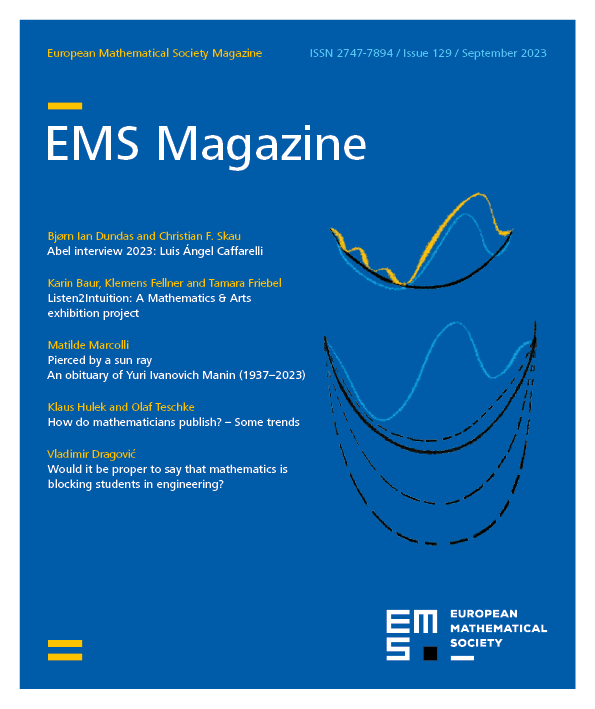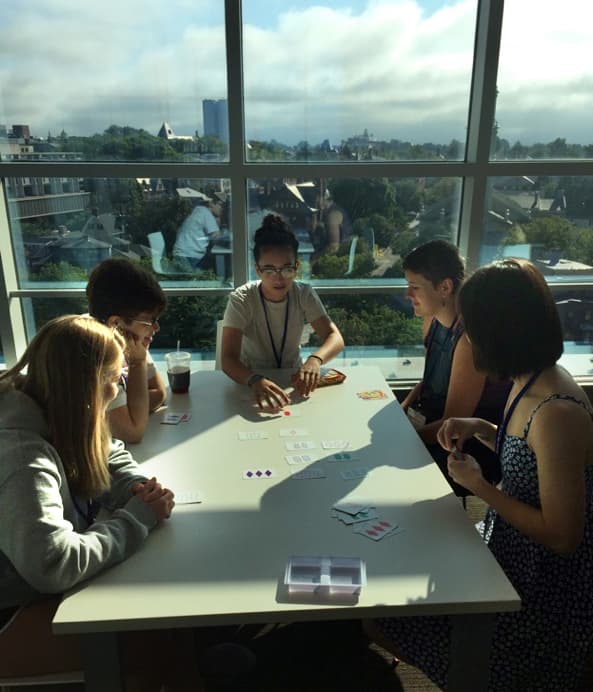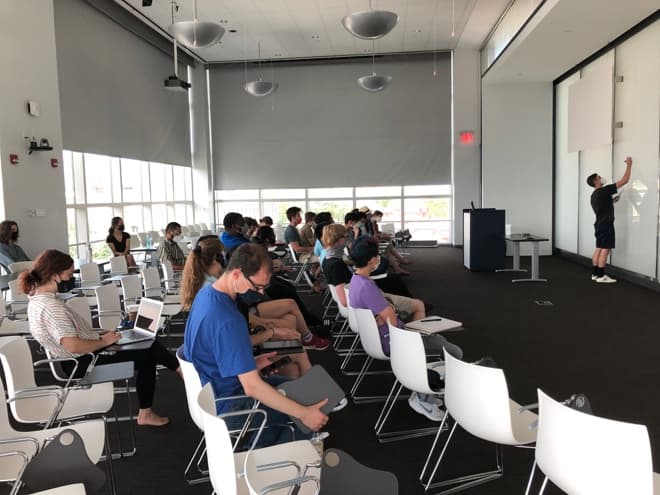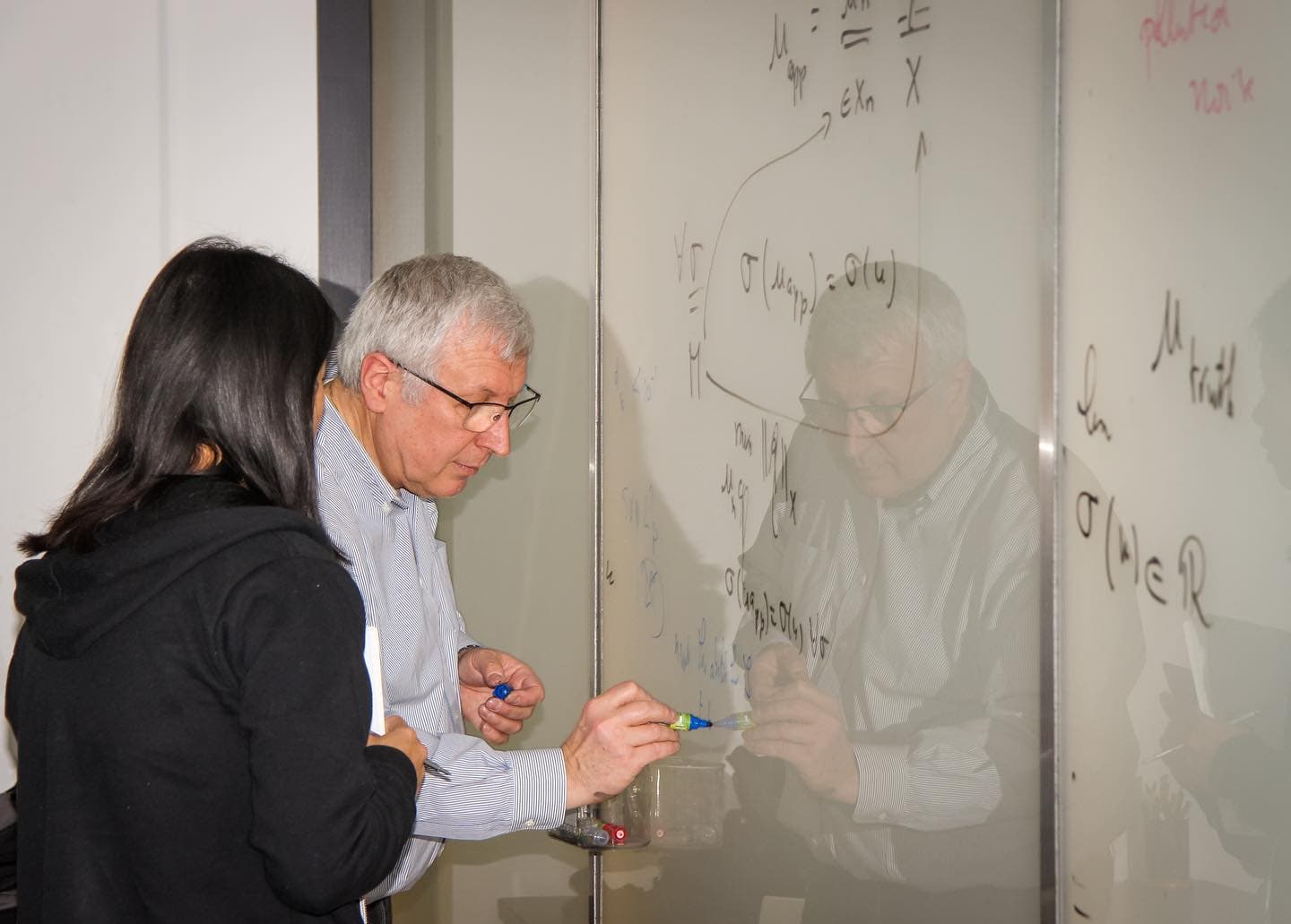Update on the Institute for Computational and Experimental Research in Mathematics
Ten years ago, in the September 2013 issue of the Newsletter of the EMS, an article presented the newly opened Institute for Computational and Experimental Research in Mathematics (ICERM). This once fledgling center has now grown into a mature institute, and this article aims to reintroduce ICERM to the international mathematical community, provide an update on its achievements over the last decade, and encourage mathematical scientists of all stages to participate in its future.
ICERM
Since its opening in Fall 2011, ICERM has run 23 semester programs, 74 topical workshops, 36 public lectures, 12 summer training programs for graduate students and multiple other events. Despite the tumultuous last few years that have forced the organizational team to navigate safety concerns, evolutions in the job market, growing awareness of the climate and social impact of research, ICERM has developed a robust operation that supports organizers as they carry out mathematically rigorous, bold, large-scale programs. With guaranteed funding at least until 2025, ICERM encourages all mathematicians to apply to participate in one of the already planned programs, or to propose an ambitious new one.
ICERM is located on the top floors of a modern building on the waterfront in downtown Providence.
©ICERM
What is ICERM?
ICERM is an institute with core funding from the National Science Foundation (NSF), located in Providence, Rhode Island. Its principal focus is to bring together pure and applied mathematicians from all specialties and all institutions through a variety of programs. At ICERM, participants come together to collaborate, share, and develop ideas and experiments, and formulate and test conjectures to expand the boundaries of science.
Among all NSF institutes, ICERM is uniquely focused on experiments in both pure and applied mathematics. Its mission is to “support and broaden the relationship between mathematics and computation: specifically, to expand the use of computational and experimental methods in mathematics, support theoretical advances related to computation, and address problems posed by the existence and use of the computer through mathematical tools, research and innovation.” As such it seeks, in particular, to disseminate new computer-based tools and to accompany and facilitate emerging topics in mathematics. Its location on the East coast, integrated into one of the largest scientific eco-systems in the world, allows ICERM to stay at the forefront of recent developments and trends.
ICERM’s Fall 2019 semester program “Illustrating Mathematics” included an art exhibition for researchers.
©ICERM
ICERM is especially devoted to nurturing young researchers in mathematics. In addition to a few institute postdocs, who stay for a year, each semester program supports a large number of 6-months-long postdocs and the program gives a chance to meet and interact with many important people in the corresponding field who can become future colleagues, collaborators or employers. Throughout the year, professional development events are organized about all aspects of academic life and work, as well as about life outside of academia.
ICERM’s amenities
ICERM occupies about 1,800 square meters on the top two floors of a modern glass building overlooking the waterfront, near downtown Providence, RI. It is centrally located near the train station, restaurants, and the Brown University campus. It is an ideal place for lectures and collaboration, with a large, welcoming communal space and an auditorium that can accommodate 120 people and is fully equipped for online recording and participation. In addition, it contains a conference room, a lecture room and 25 offices for long-term participants in a lower story, with floor to ceiling blackboard-paint on the walls to allow the free flow of ideas and spontaneous discussions and collaborations. For special programs, additional resources can be secured (such as 3D printers for a semester focused on art and mathematics).
The institute provides all long-term visitors with access to a broad range of compilers, numerical libraries, mathematical problem-solving environments, visualization software, statistical packages, and productivity software hosted in a virtual desktop and/or terminal based environment. Additionally, all long-term visitors are given exploratory level access to Brown’s high performance computing resources. The goal is to provide participants with a wide variety of tools to experiment with and allow them to sample options that may not be otherwise familiar, in order to maximize potential avenues for research.
In addition, ICERM’s IT team works with program organizers to tailor technical offerings to support their vision. This may include leveraging resources at Brown in a customized way, like reserving GPU nodes for computer operations or standing up containerized environments, utilizing cloud-based services like CoCalc and Overleaf, standing up custom systems using Microsoft Azure or Amazon Web Services, or acquiring and supporting physical tools such as 3D printers and VR headsets.
Global pandemics notwithstanding, most programs are in person. However, talks are streamed live on the website, where many recordings of past presentations can also be found.
Programming at ICERM
ICERM hosts a variety of events whose formats vary from one-day meetings to semester-long programs. The following are the principal types of activities, usually involving participants from all over the world.
Semester programs are the backbone of the institute. Programs are selected from applications made by teams of mathematicians from anywhere in the world, and typically organized 2 to 3 years in advance. They bring together about 20 senior participants and a similar number of junior participants who stay in residence for the semester, and about 100 shorter-term visitors, who stay from a few days to a few weeks.
Topical workshops are the shorter, smaller equivalent of the semester programs. They are organized 12 to 18 months in advance and bring together about 30 specialists for a week of conference, collaboration, discussion and/or training.
Hot topic workshops are ICERM’s rapid-response mechanism to host workshops that can be organized in a matter of weeks to keep up with, and maximize the impact of, a recent breakthrough.
Collaborate@ICERM brings together about 3 to 6 researchers to meet in person to continue an existing collaboration. This is an ideal setting to finish or expand on a collaboration initiated during one of the other ICERM programs.
Summer@ICERM is an eight-week summer program where 2 to 4 faculty organizers lead a team of about 20 undergraduate students on a research project.
Public lectures invite an expert to speak to a large audience on a topic relevant to non-mathematicians to spread awareness of, and interest in, mathematics in the broader public.
Early-career researchers gather for a poster session in ICERM’s communal space.
©ICERM
ICERM is administratively part of Brown University and ICERM’s Director, Brendan Hassett, is a permanent faculty member of Brown. From a scientific standpoint, ICERM is largely independent of the university (and the mathematics and applied mathematics departments within) and has a mission to serve the broader community of mathematicians in the US and beyond. The focus on research topics of international significance is guaranteed by Advisory Boards whose members are not affiliated with the university.
ICERM in numbers
As per geography, many (about two-thirds) of ICERM visitors are from America, but the rest come from overseas, principally Europe (more than 20%), and participants and organizers from all over the world are welcome. ICERM is primarily devoted to the whole mathematical community but brings mathematics to the local population through public lectures and the GirlsGetMath@ICERM programs.
High school students in ICERM’s GirlsGetMath program play cards in the ICERM communal space.
©ICERM
ICERM can and has partnered with other institutes throughout the world and has helped organize events in India, Japan, Singapore, and South Africa.
The institute actively promotes diversity during all its events. It regularly hosts the Blackwell–Tapia conference (in 2012 and 2018) as well as the Modern Math Workshop (in 2011, 2013 and 2017), and the Conference for African American Researchers in the Mathematical Sciences (2015). The institute is interested in all topics in interaction with mathematics. The themes of past workshops have ranged from “Computational Aspects of the Langlands Program” to “Illustrating Mathematics,” from “Computational Biology” to “Knot Theory,” and from “Data Science and Social Justice,” to “Global Arithmetic Dynamics” and “Computational Aspects of Water Waves.” No topic is off the table!
Participants attend a workshop in ICERM’s Lecture Hall.
©ICERM
Organizing a semester
Most ICERM activities are relatively easy to organize, thanks to the support of the experienced team of full-time staff. Semester programs are the most demanding for the organizers, but typically follow several steps that we outline below.
(i) The most important task is to bring together a team of (6–10) organizers around a current mathematical topic. When planning, organizers should consider other institutes’ programming schedules, so that as many researchers in the field as possible will be able to attend. Workshops should strike a good balance between theory and application. A diverse group of organizers is encouraged.
(ii) The organizers submit a proposal to the Scientific Advisory Board. Once a program is accepted and there has been an opportunity for feedback, a date will be agreed upon. Programs typically occur two years after acceptance.
(iii) Over the next year, the organizers start to advertise the program and converge on a list of senior participants. The main challenge at this stage is to informally secure the presence of key long-term participants and to make sure that young mathematicians are aware of the application timeline for the postdoctoral positions.
(iv) About a year before the start of the program, invitations are sent to most participants to secure their stay. Accepted postdoctoral fellows are notified in the spring before the program (ICERM postdocs are selected from a pool of applicants on Mathjobs.org).
(v) Around this time the general structure of the program is also finalized. Usually, a program is structured around 3 week-long workshops. The themes and organizing teams of these workshops are decided. In addition, appropriate steps for ensuring a diversity of participants and promoting the development of junior attendees are put in place.
(vi) About 6 months before the beginning of the program, invitations are sent for the workshops, and to short-term participants.
(vii) At the beginning of the semester, the organizers finalize additional events taking place outside of the workshop weeks, e.g., regular seminars throughout the semester and working groups. They also assign mentors to each of the junior participants.
(viii) Throughout the semester, the ICERM staff will organize regular activities and career-building events for the junior participants.
Many of ICERM’s walls double as workspaces for researchers.
©ICERM
These broad guidelines are flexible and can be adapted depending on the needs of the program. For instance, a program with a significant industry interface where the people concerned may not be able to come to Providence for an extended time can involve Research Clusters, which are intensive, several weeks-long events more adapted to the industry timeline.
Conclusions
We hope that this article inspires mathematicians to participate in or organize a program at ICERM. All areas of mathematics, especially nascent and developing mathematical fields, are supported. One of the goals of ICERM is to nurture experiments, help produce conjectures or look for counterexamples and set up standards for explorations of new mathematics. ICERM is the perfect place to explore and create new horizons in mathematics!
Cite this article
Benoît Pausader, ICERM: 10 years later. Eur. Math. Soc. Mag. 129 (2023), pp. 32–35
DOI 10.4171/MAG/151






